Resume
Structural Engineer Cover Letter Examples

May 29, 2025
|
12 min read
Master the art of crafting a compelling structural engineer cover letter with tips and tricks for standing out like a steel beam. Learn how to build a strong foundation for your job application.
4.70 Average rating
Rated by 348 people
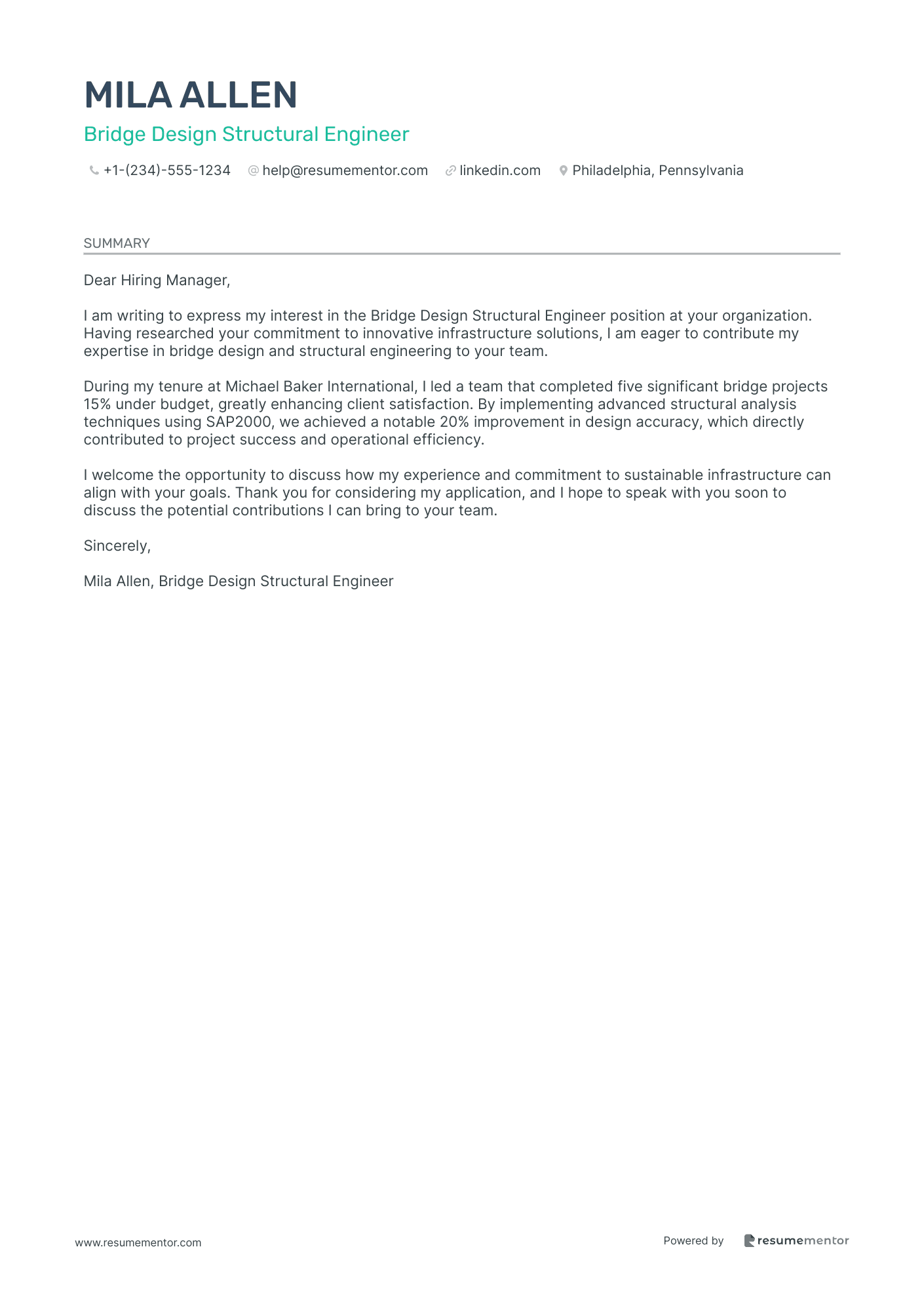
Bridge Design Structural Engineer
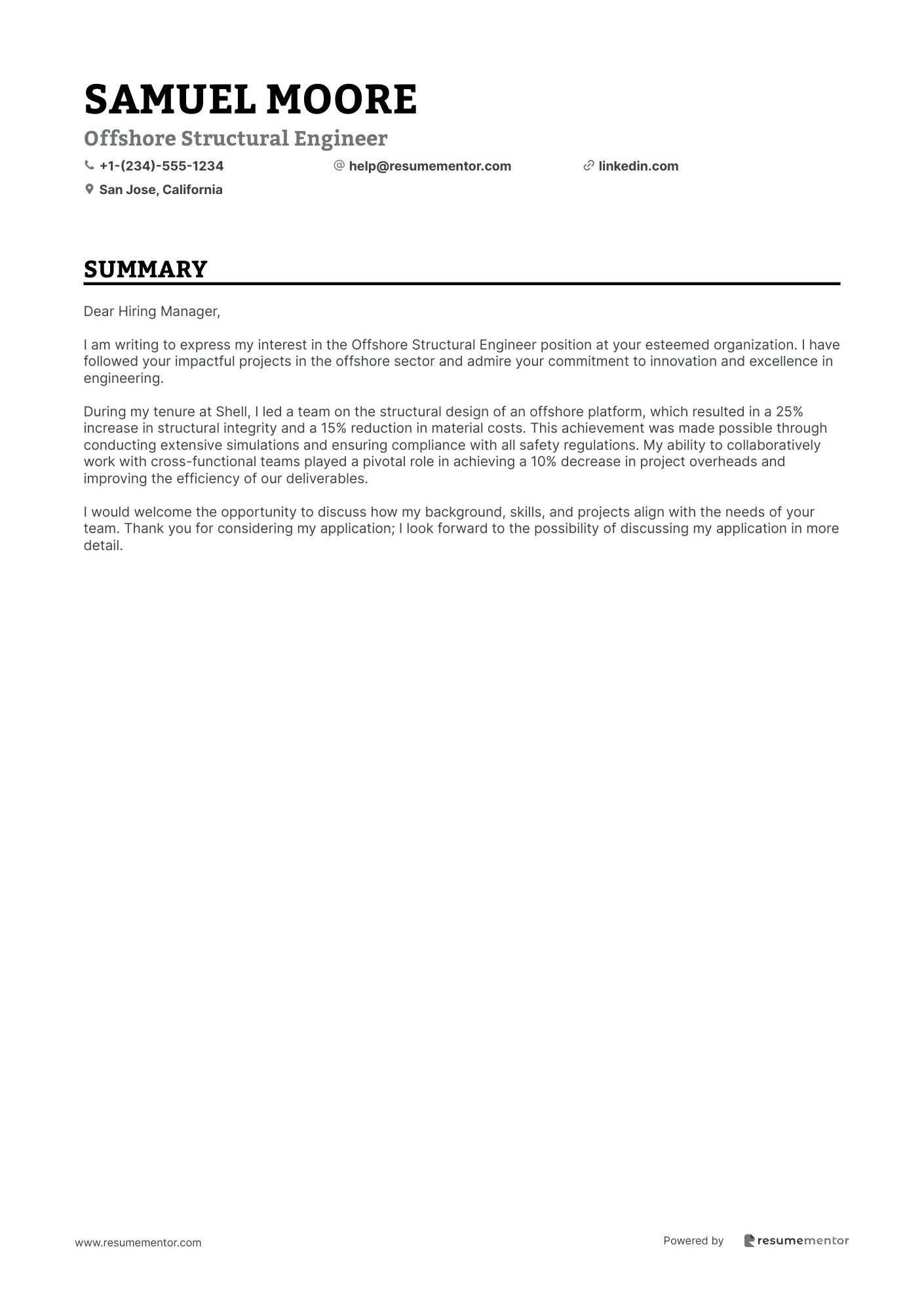
Offshore Structural Engineer
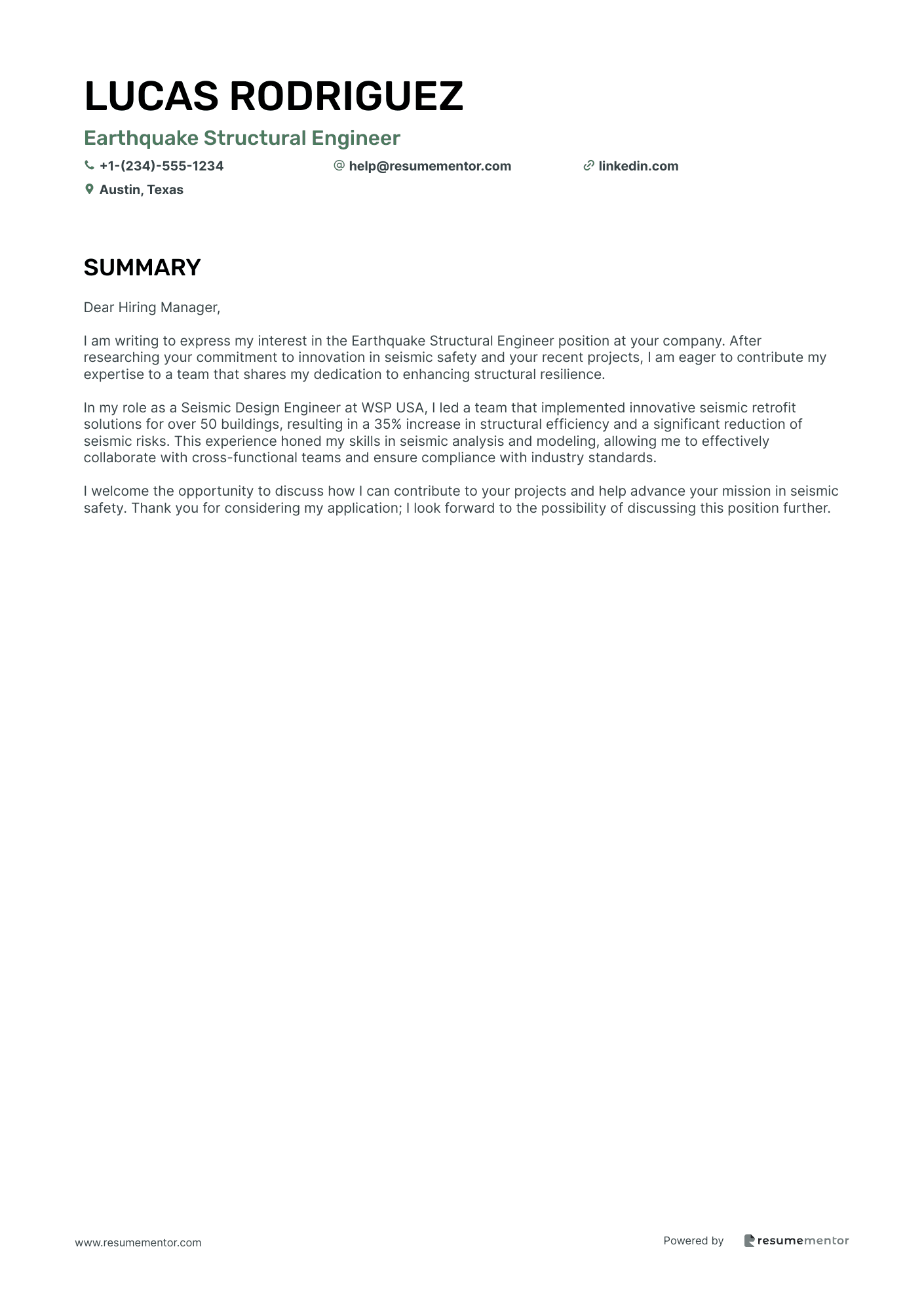
Earthquake Structural Engineer
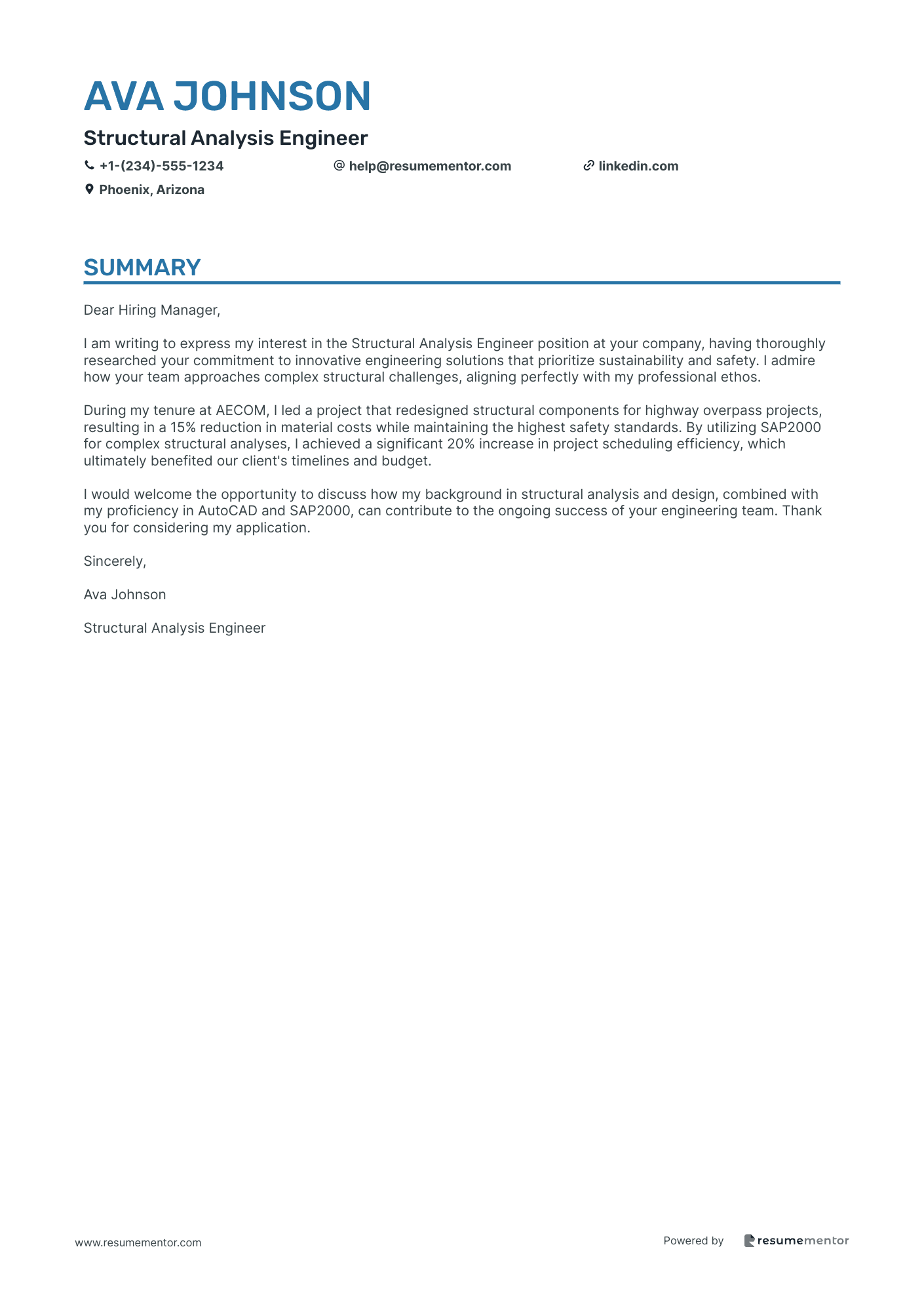
Structural Analysis Engineer
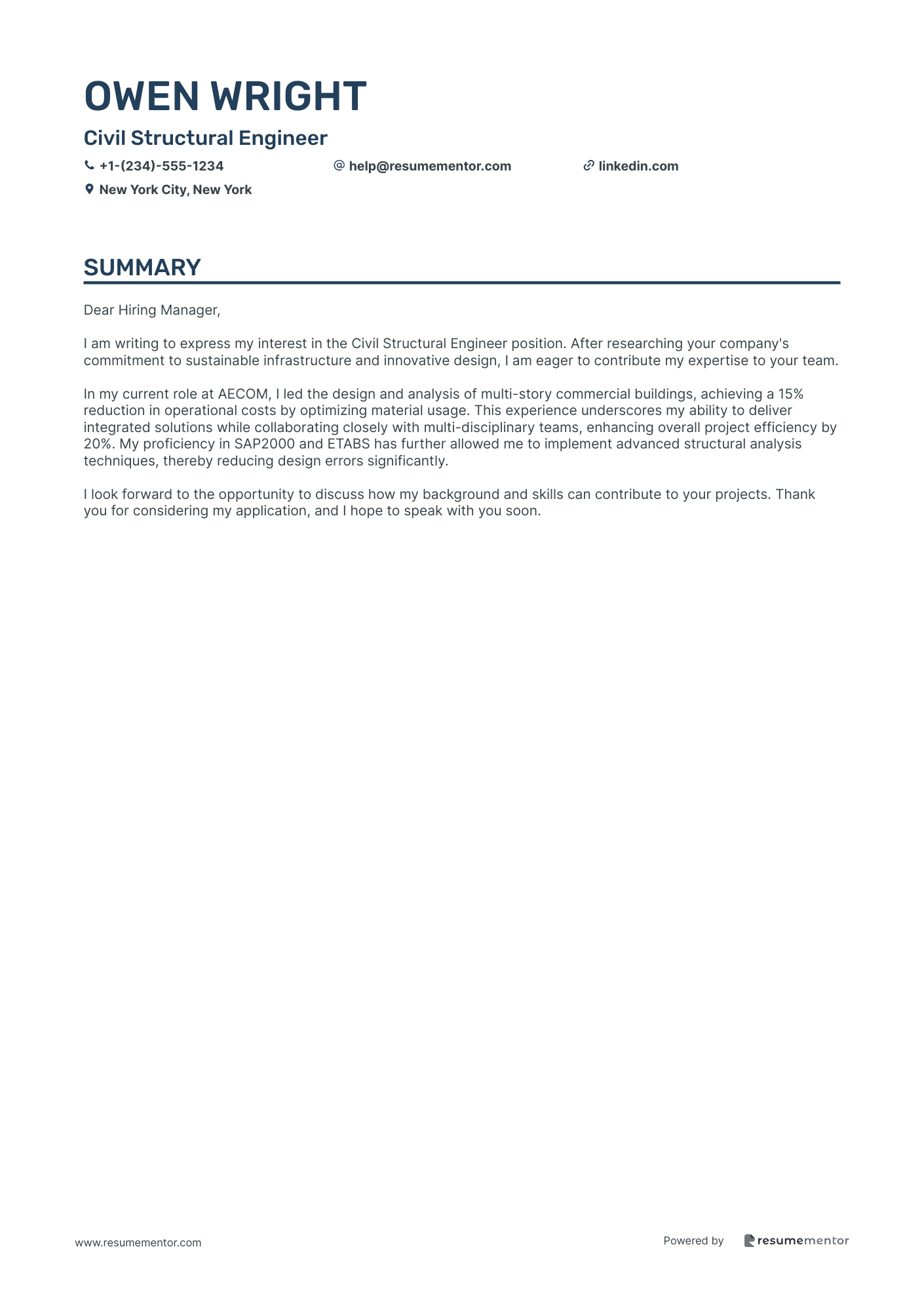
Civil Structural Engineer
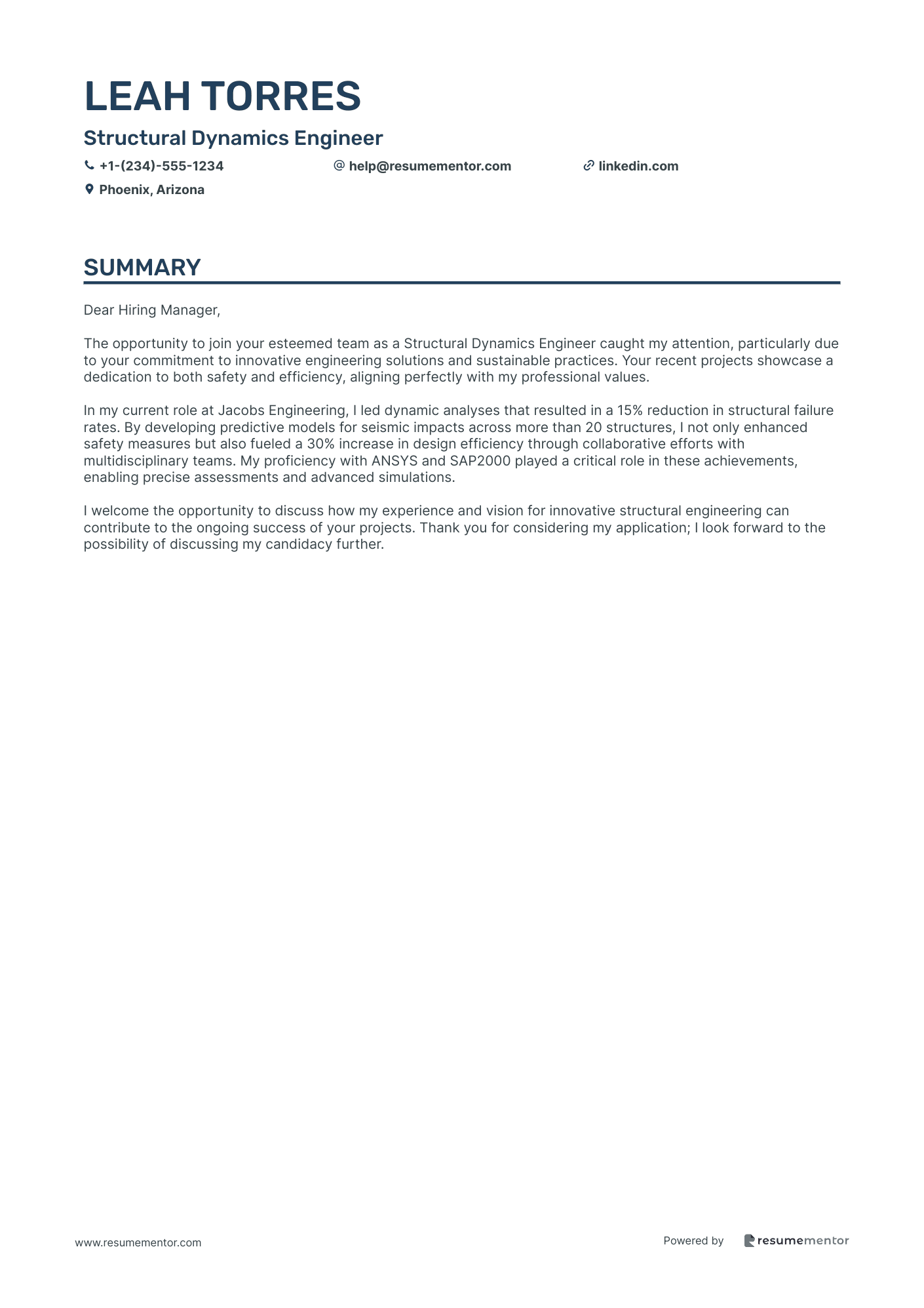
Structural Dynamics Engineer
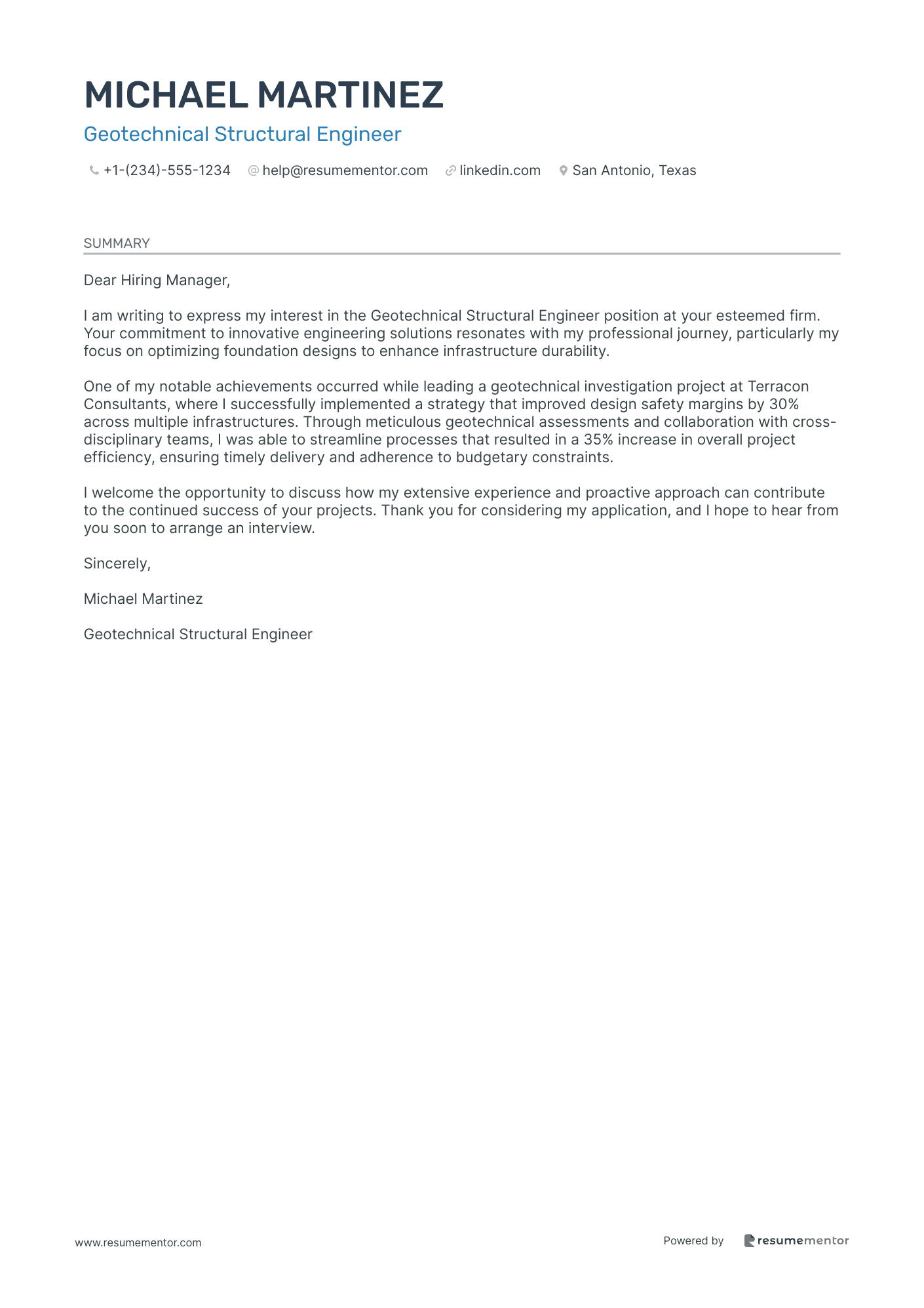
Geotechnical Structural Engineer
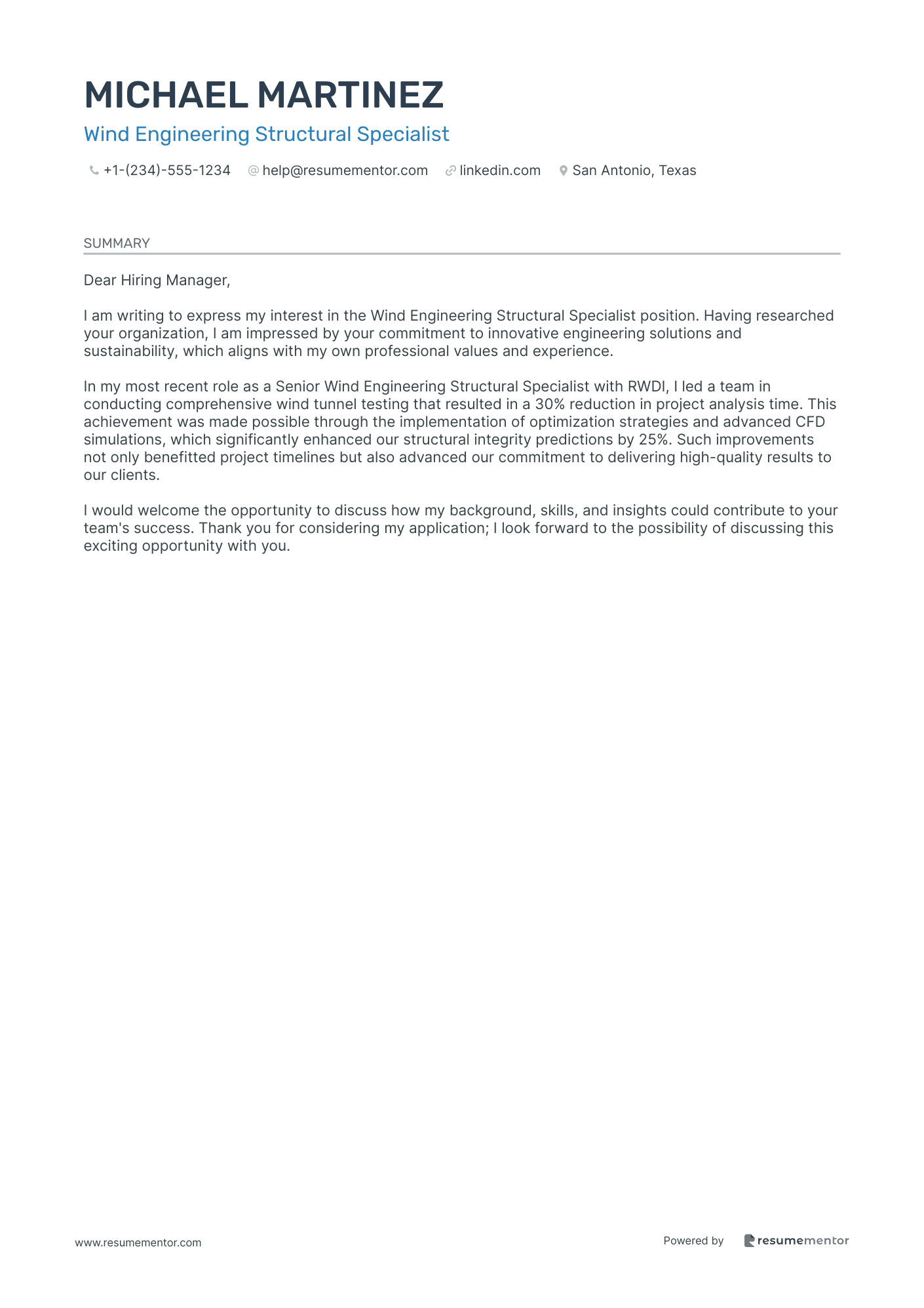
Wind Engineering Structural Specialist
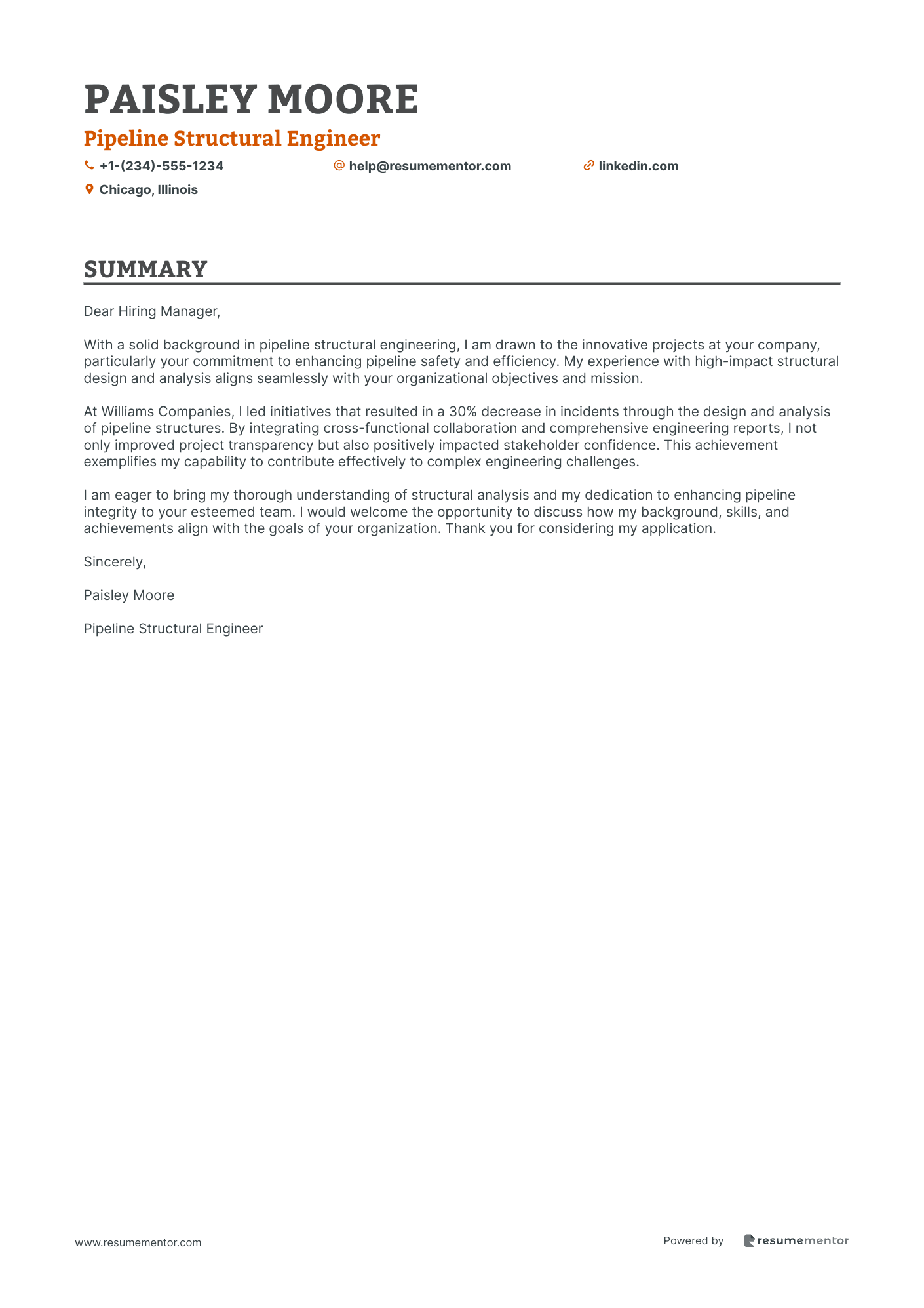
Pipeline Structural Engineer
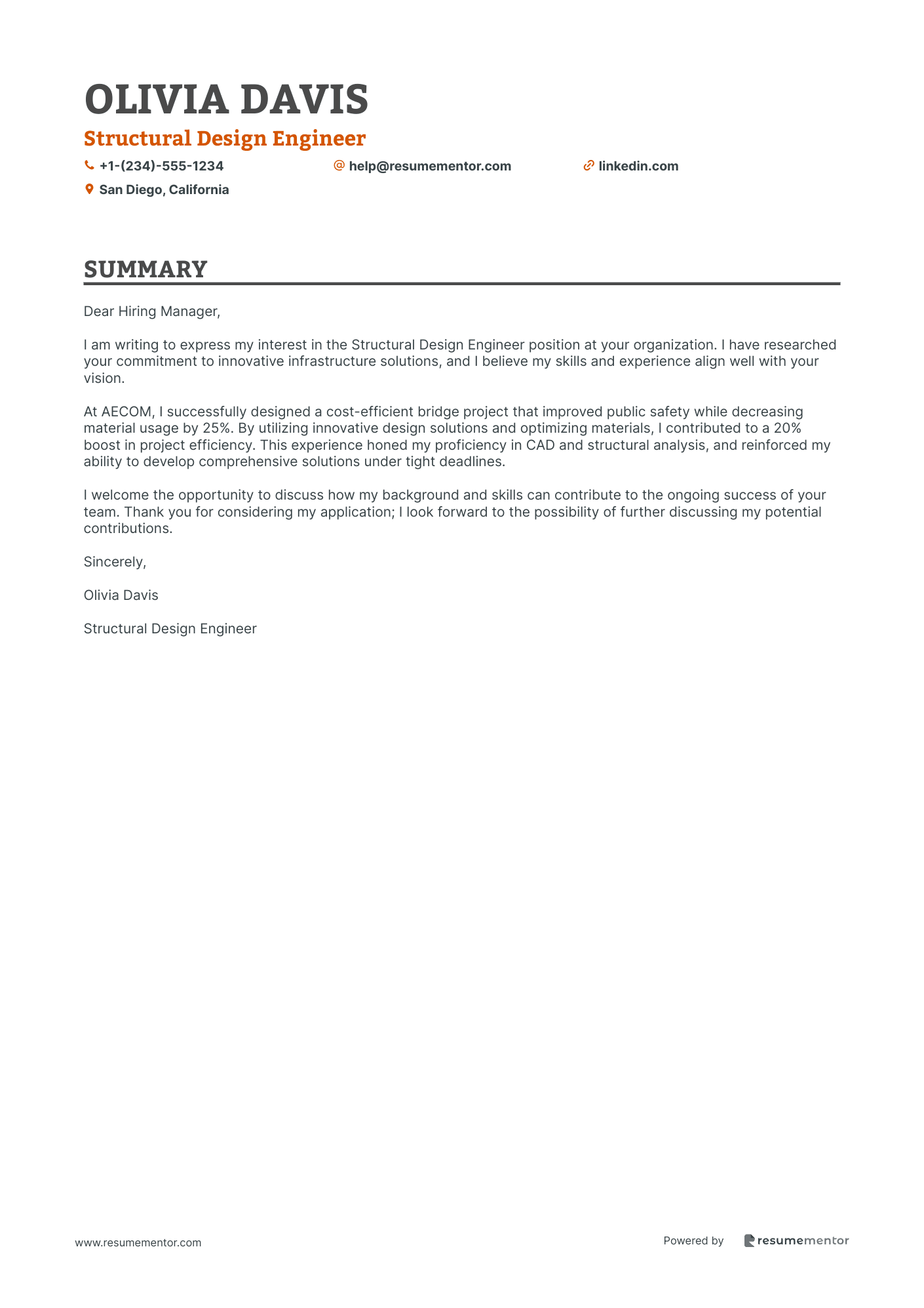
Structural Design Engineer

Bridge Design Structural Engineer cover letter sample
When applying for this position, emphasize your experience with structural analysis and design software such as AutoCAD and Revit. Highlight your knowledge of relevant codes and standards, like AASHTO or Eurocode. If you have certifications, such as Professional Engineer (PE) status or related training, be sure to mention these accomplishments. Share specific projects where your design improved safety, reduced costs, or enhanced project timelines. Use a 'challenge-action-result' format to demonstrate how your contributions made a measurable impact on your previous teams and projects.
Mila Allen
Bridge Design Structural Engineer
Summary
Dear Hiring Manager,
I am writing to express my interest in the Bridge Design Structural Engineer position at your organization. Having researched your commitment to innovative infrastructure solutions, I am eager to contribute my expertise in bridge design and structural engineering to your team.
During my tenure at Michael Baker International, I led a team that completed five significant bridge projects 15% under budget, greatly enhancing client satisfaction. By implementing advanced structural analysis techniques using SAP2000, we achieved a notable 20% improvement in design accuracy, which directly contributed to project success and operational efficiency.
I welcome the opportunity to discuss how my experience and commitment to sustainable infrastructure can align with your goals. Thank you for considering my application, and I hope to speak with you soon to discuss the potential contributions I can bring to your team.
Sincerely,
Mila Allen, Bridge Design Structural Engineer
Offshore Structural Engineer cover letter sample
When writing your cover letter, highlight any experience with structural design and analysis, particularly in offshore projects. Emphasize your proficiency in relevant software like AutoCAD, Revit, or SAP2000. Mention specific projects where your engineering insights led to improved safety or reduced costs. Include certifications such as a Professional Engineer (PE) license or relevant training in offshore safety. Use concrete examples demonstrating how your technical skills and problem-solving abilities have positively impacted past projects. Focus on teamwork and collaboration, illustrating how you have worked effectively in diverse teams.
Samuel Moore
Offshore Structural Engineer
Summary
Dear Hiring Manager,
I am writing to express my interest in the Offshore Structural Engineer position at your esteemed organization. I have followed your impactful projects in the offshore sector and admire your commitment to innovation and excellence in engineering.
During my tenure at Shell, I led a team on the structural design of an offshore platform, which resulted in a 25% increase in structural integrity and a 15% reduction in material costs. This achievement was made possible through conducting extensive simulations and ensuring compliance with all safety regulations. My ability to collaboratively work with cross-functional teams played a pivotal role in achieving a 10% decrease in project overheads and improving the efficiency of our deliverables.
I would welcome the opportunity to discuss how my background, skills, and projects align with the needs of your team. Thank you for considering my application; I look forward to the possibility of discussing my application in more detail.
Earthquake Structural Engineer cover letter sample
When applying for this role, emphasize any relevant experience in seismic design and analysis. Include any projects where you successfully designed structures to withstand earthquakes. Highlight proficiency in software such as SAP2000 or ETABS and any qualifications or certification in structural engineering. Demonstrate how your attention to detail has improved safety and compliance in past projects. Use specific examples to illustrate how your engineering decisions have minimized risk or enhanced structural integrity, following a 'skill-action-result' approach for clarity and impact.
Lucas Rodriguez
Earthquake Structural Engineer
Summary
Dear Hiring Manager,
I am writing to express my interest in the Earthquake Structural Engineer position at your company. After researching your commitment to innovation in seismic safety and your recent projects, I am eager to contribute my expertise to a team that shares my dedication to enhancing structural resilience.
In my role as a Seismic Design Engineer at WSP USA, I led a team that implemented innovative seismic retrofit solutions for over 50 buildings, resulting in a 35% increase in structural efficiency and a significant reduction of seismic risks. This experience honed my skills in seismic analysis and modeling, allowing me to effectively collaborate with cross-functional teams and ensure compliance with industry standards.
I welcome the opportunity to discuss how I can contribute to your projects and help advance your mission in seismic safety. Thank you for considering my application; I look forward to the possibility of discussing this position further.
Structural Analysis Engineer cover letter sample
When writing your cover letter, highlight any experience with structural analysis software such as SAP2000 or ANSYS. Showcase your familiarity with design codes and standards, emphasizing your understanding of load calculations and material properties. Mention specific projects where your analysis contributed to safety and efficiency. Include any relevant certifications like FE or PE to demonstrate your commitment. Use examples to illustrate how your analytical skills improved project outcomes, focusing on the impact of your contributions on budget and timeline adherence.
Ava Johnson
Structural Analysis Engineer
Summary
Dear Hiring Manager,
I am writing to express my interest in the Structural Analysis Engineer position at your company, having thoroughly researched your commitment to innovative engineering solutions that prioritize sustainability and safety. I admire how your team approaches complex structural challenges, aligning perfectly with my professional ethos.
During my tenure at AECOM, I led a project that redesigned structural components for highway overpass projects, resulting in a 15% reduction in material costs while maintaining the highest safety standards. By utilizing SAP2000 for complex structural analyses, I achieved a significant 20% increase in project scheduling efficiency, which ultimately benefited our client's timelines and budget.
I would welcome the opportunity to discuss how my background in structural analysis and design, combined with my proficiency in AutoCAD and SAP2000, can contribute to the ongoing success of your engineering team. Thank you for considering my application.
Sincerely,
Ava Johnson
Structural Analysis Engineer
Civil Structural Engineer cover letter sample
When applying for this position, you should emphasize your technical skills in structural analysis and design. Highlight any experience with software like AutoCAD or SAP2000, as this demonstrates your proficiency in modern engineering tools. Include details about any projects you've worked on, focusing on your role and the results achieved, such as cost savings or efficiency improvements. If you've participated in relevant workshops or earned certifications like Project Management Professional (PMP), make sure to mention these, showcasing your commitment to continual learning in the field.
Owen Wright
Civil Structural Engineer
Summary
Dear Hiring Manager,
I am writing to express my interest in the Civil Structural Engineer position. After researching your company's commitment to sustainable infrastructure and innovative design, I am eager to contribute my expertise to your team.
In my current role at AECOM, I led the design and analysis of multi-story commercial buildings, achieving a 15% reduction in operational costs by optimizing material usage. This experience underscores my ability to deliver integrated solutions while collaborating closely with multi-disciplinary teams, enhancing overall project efficiency by 20%. My proficiency in SAP2000 and ETABS has further allowed me to implement advanced structural analysis techniques, thereby reducing design errors significantly.
I look forward to the opportunity to discuss how my background and skills can contribute to your projects. Thank you for considering my application, and I hope to speak with you soon.
Structural Dynamics Engineer cover letter sample
When applying for this position, it’s essential to highlight any experience with dynamic analysis software and finite element modeling. Mention your proficiency in tools like ANSYS or MATLAB, as these are key for the role. Include relevant coursework, such as 'Vibrations and Dynamics of Structures', to showcase your technical foundation. If you've successfully completed projects that improved structural integrity, detail these using the 'challenge-action-result' format. Be sure to express your problem-solving skills and how they contributed to successful project outcomes.
Leah Torres
Structural Dynamics Engineer
Summary
Dear Hiring Manager,
The opportunity to join your esteemed team as a Structural Dynamics Engineer caught my attention, particularly due to your commitment to innovative engineering solutions and sustainable practices. Your recent projects showcase a dedication to both safety and efficiency, aligning perfectly with my professional values.
In my current role at Jacobs Engineering, I led dynamic analyses that resulted in a 15% reduction in structural failure rates. By developing predictive models for seismic impacts across more than 20 structures, I not only enhanced safety measures but also fueled a 30% increase in design efficiency through collaborative efforts with multidisciplinary teams. My proficiency with ANSYS and SAP2000 played a critical role in these achievements, enabling precise assessments and advanced simulations.
I welcome the opportunity to discuss how my experience and vision for innovative structural engineering can contribute to the ongoing success of your projects. Thank you for considering my application; I look forward to the possibility of discussing my candidacy further.
Geotechnical Structural Engineer cover letter sample
When applying for this position, focus on your experience with soil analysis and foundation design. Highlight any projects that demonstrate your ability to solve complex structural problems. Mention relevant software skills, like AutoCAD or PLAXIS, and coursework in geotechnical engineering. Certifications, such as the Professional Engineer (PE) license, can also strengthen your application. Include specific outcomes from past projects using the 'skill-action-result' method to showcase how your contributions improved safety, reduced costs, or enhanced structural integrity for your previous employers.
Michael Martinez
Geotechnical Structural Engineer
Summary
Dear Hiring Manager,
I am writing to express my interest in the Geotechnical Structural Engineer position at your esteemed firm. Your commitment to innovative engineering solutions resonates with my professional journey, particularly my focus on optimizing foundation designs to enhance infrastructure durability.
One of my notable achievements occurred while leading a geotechnical investigation project at Terracon Consultants, where I successfully implemented a strategy that improved design safety margins by 30% across multiple infrastructures. Through meticulous geotechnical assessments and collaboration with cross-disciplinary teams, I was able to streamline processes that resulted in a 35% increase in overall project efficiency, ensuring timely delivery and adherence to budgetary constraints.
I welcome the opportunity to discuss how my extensive experience and proactive approach can contribute to the continued success of your projects. Thank you for considering my application, and I hope to hear from you soon to arrange an interview.
Sincerely,
Michael Martinez
Geotechnical Structural Engineer
Wind Engineering Structural Specialist cover letter sample
When applying for this role, focus on your experience with wind load analysis and structural design principles. Highlight your proficiency in using software like ANSYS or SAP2000, as these are vital tools for the job. Include any relevant projects where you analyzed the effects of wind on structures. Emphasize any certifications, such as a Professional Engineer license or training in advanced structural analysis. Share specific examples demonstrating how your designs improved safety or efficiency, using a 'skill-action-result' framework to illustrate your impact.
Michael Martinez
Wind Engineering Structural Specialist
Summary
Dear Hiring Manager,
I am writing to express my interest in the Wind Engineering Structural Specialist position. Having researched your organization, I am impressed by your commitment to innovative engineering solutions and sustainability, which aligns with my own professional values and experience.
In my most recent role as a Senior Wind Engineering Structural Specialist with RWDI, I led a team in conducting comprehensive wind tunnel testing that resulted in a 30% reduction in project analysis time. This achievement was made possible through the implementation of optimization strategies and advanced CFD simulations, which significantly enhanced our structural integrity predictions by 25%. Such improvements not only benefitted project timelines but also advanced our commitment to delivering high-quality results to our clients.
I would welcome the opportunity to discuss how my background, skills, and insights could contribute to your team's success. Thank you for considering my application; I look forward to the possibility of discussing this exciting opportunity with you.
Pipeline Structural Engineer cover letter sample
When crafting your cover letter, focus on your experience with software tools like AutoCAD or SolidWorks, as these are essential for this role. Highlight projects where you designed or analyzed pipe systems, detailing the specific outcomes of your efforts. Mention any relevant certifications, such as Professional Engineer (PE) or related industry training. It’s important to demonstrate your understanding of industry standards and regulations. Provide concrete examples of how your designs improved efficiency, reduced costs, or enhanced safety in previous positions, using a clear 'skill-action-result' format to show impact.
Paisley Moore
Pipeline Structural Engineer
Summary
Dear Hiring Manager,
With a solid background in pipeline structural engineering, I am drawn to the innovative projects at your company, particularly your commitment to enhancing pipeline safety and efficiency. My experience with high-impact structural design and analysis aligns seamlessly with your organizational objectives and mission.
At Williams Companies, I led initiatives that resulted in a 30% decrease in incidents through the design and analysis of pipeline structures. By integrating cross-functional collaboration and comprehensive engineering reports, I not only improved project transparency but also positively impacted stakeholder confidence. This achievement exemplifies my capability to contribute effectively to complex engineering challenges.
I am eager to bring my thorough understanding of structural analysis and my dedication to enhancing pipeline integrity to your esteemed team. I would welcome the opportunity to discuss how my background, skills, and achievements align with the goals of your organization. Thank you for considering my application.
Sincerely,
Paisley Moore
Pipeline Structural Engineer
Structural Design Engineer cover letter sample
When applying, focus on any previous experience with structural analysis and design software. Highlight your proficiency in tools like AutoCAD or Revit, as these are essential. Mention any relevant degrees or certifications, such as a Professional Engineer (PE) license. Use the 'skill-action-result' format to present examples of how your design improvements have led to cost savings or increased safety in past projects. Demonstrating your ability to collaborate with architects and construction teams is crucial, as teamwork is vital in this field.
Olivia Davis
Structural Design Engineer
Summary
Dear Hiring Manager,
I am writing to express my interest in the Structural Design Engineer position at your organization. I have researched your commitment to innovative infrastructure solutions, and I believe my skills and experience align well with your vision.
At AECOM, I successfully designed a cost-efficient bridge project that improved public safety while decreasing material usage by 25%. By utilizing innovative design solutions and optimizing materials, I contributed to a 20% boost in project efficiency. This experience honed my proficiency in CAD and structural analysis, and reinforced my ability to develop comprehensive solutions under tight deadlines.
I welcome the opportunity to discuss how my background and skills can contribute to the ongoing success of your team. Thank you for considering my application; I look forward to the possibility of further discussing my potential contributions.
Sincerely,
Olivia Davis
Structural Design Engineer
Related Articles
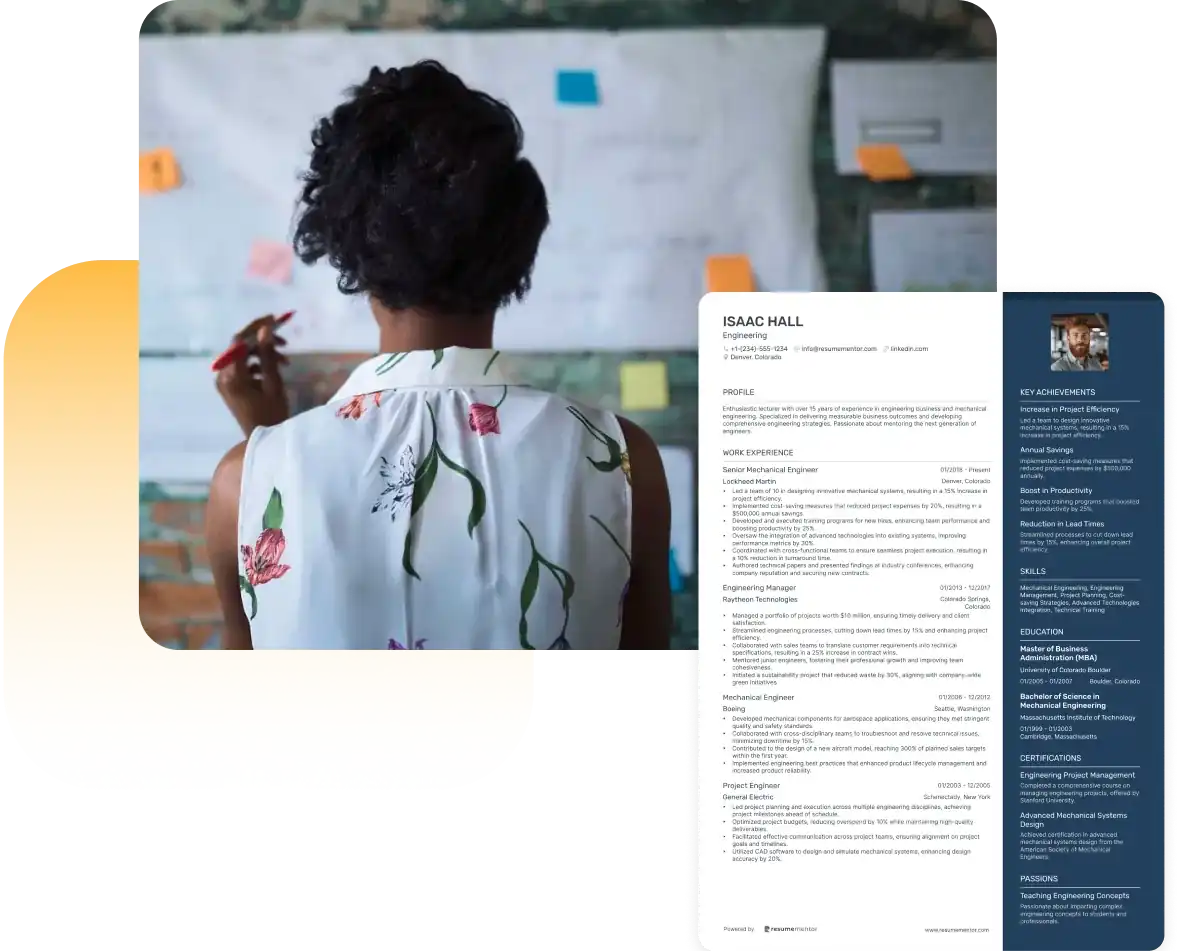
Continue Reading
Check more recommended readings to get the job of your dreams.
Resume
Resources
Tools
© 2025. All rights reserved.
Made with love by people who care.
